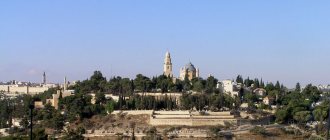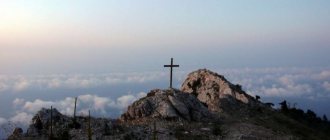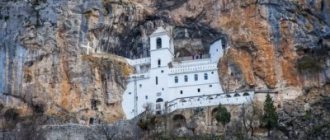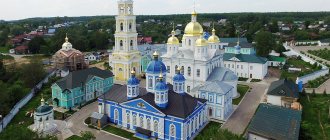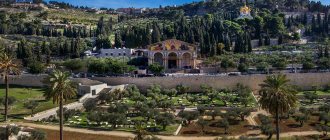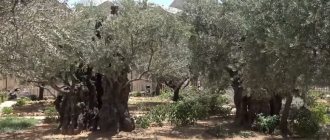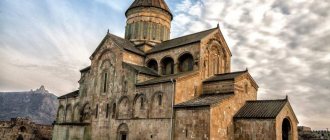Egypt is considered to be a country of beach holidays. However, how many amazing and soul-stirring places await the adventurer in these parts. One of them is Mount Sinai. Every day up to several hundred people climb the mountain. Their path is not easy; through the night they walk from the deserted dry desert along narrow paths to the top. History will help you find out what they are looking for, what awaits them at the top.
History of Mount Sinai
According to belief, for those who overcome this path and reach the top , God forgives all sins .
Sinai has become a special place for believers. Here, on a mountain in the desert, according to the Bible, the Lord appeared to Moses, spoke to him and gave him the Ten Commandments - spiritual laws that for many decades were the basis of morality for all nations.
The exact location of the sacred place described in biblical history is not known for certain. In addition to the Egyptian mountain on the Sinai Peninsula, at least three more mountains in various countries - Jordan, Israel and Saudi Arabia - claim to be considered the same place described in the Bible. However, thanks to the artifacts found, it is generally accepted that it was on Mount Sinai that Moses received the Tablets of the Covenant. This happened nearly 3,500 years ago, but to this day history keeps many secrets.
The mountain has many names - Mount Horeb, Mount Har Sinai, Holy Mountain, Mountain of God. And the most used among our compatriots is the mountain of Moses. This variety of names is due to the fact that three religions intersect in this place - Christian, Muslim and Jewish.
There are several references to Mount Sinai in the Koran, and Muslims claim that in this place the prophet Musa was given a covenant by Allah.
Despite the absence of specific instructions in the Old Testament and the Torah about the exact location on the map, from the 2nd–3rd centuries. n. e. hermits professing Christianity began to populate this part of Sinai. The veneration of the mountain as a place called Exodus in the Old Testament begins in the 4th century AD. e.
Story
Tradition says that this is the very peak on which Moses received a revelation from God: two stone tablets on which the 10 commandments were written. This was during the exodus of the Jews from Egypt: in the third month they stopped at the foot of the mountain and remained there for more than a year. Moses, after receiving the revelation, set up an altar at the foot of the mountain, and then again retired to it to pray. During this time, the Jews forgot about the faith of their fathers and began to worship the golden calf, and this angered the prophet.
Once again this mountain is mentioned in the Bible in connection with the prophet Elijah - he also went here to pray. A later legend connected the place with another biblical episode: it is believed that even before the Exodus, Moses was a shepherd, and it was in these places that the Burning Bush appeared to him - a bush that burned with fire and did not burn, and it was from the Burning Bush that God ordered Moses to bring Jews from Egypt.
Stone arch above the “Staircase of Repentance”, © Sergey Vasilets
The Bible does not indicate the exact location of the legendary mountain, so several mountain peaks claimed the title of “real Sinai.” By the 4th century. n. e. This is precisely what has been established in the Christian tradition. Hermits began to settle here, and the first chapel and fortified tower appeared on the mountainside. In the VI century. At the foot of the mountain the Monastery of St. Catherine - its main shrines are considered to be precisely that same bush - the Burning Bush - and the relics of the Holy Great Martyr Catherine. Numerous pilgrims began to combine visits to the top of Mount Sinai and this monastery. In the 9th century. A mosque also appeared on the mountain: Muslims also revere the mountain as sacred. A little later, in the 12th century, a Catholic chapel was built. Even a special knightly order was founded, whose task was to help pilgrims heading to Sinai.
Russians also visited here: for example, the notes of the monk Barsanuphius, who visited here in the 15th century, have been preserved. and left a description of the monastery and Mount Sinai. Monastery of St. Catherine received rich donations from Russia, starting with Ivan the Terrible and ending with Nicholas II.
© Ljubov__Shelkotunova
Monastery of St. Catherine
One of the attractions located near Mount Sinai is the monastery of St. Catherine, ancient and amazing. It appeared on the site of a small chapel, which was ordered to be built by the Byzantine Empress Helen Equal to the Apostles, mother of Emperor Constantine, after she visited the Holy Mountain. She went on her pilgrimage after learning about the biblical parable about the bush that burned under the prophet Moses - the Burning Bush.
In 324, near the Burning Bush, Empress Helena supported the construction by the monks of a small chapel - a chapel. Over time, a whole monastery was established on the site of the chapel , the inhabitants of which were Orthodox Greeks. Since the Burning Bush monastery was often subject to raids by nomadic tribes, two centuries later, in 537, the Byzantine Emperor Yunistian I rebuilt the stone monastery in the form of a fortified fortress. In this form, with high fortress walls with loopholes, it has been preserved to this day.
However, from the 11th century, the monastery of the Burning Bush was renamed the monastery of St. Catherine in honor of the martyr, born at the end of the 3rd century. It was a difficult time for Christians - paganism remained the main religion of Egypt, and preachers of Christianity were persecuted, brutally tortured and killed. But even at the cost of their lives, becoming martyrs, people who accepted and came to know faith in Christ carried his word. One of these enlighteners was a beautiful, educated and intelligent girl from a noble family of Alexandria - Dorothea. Having converted to Christianity, she received the name Catherine and devoted her life to preaching.
The monastery is located at an altitude of just over 1570 meters and is considered the oldest Christian building in the world. It includes more than a hundred buildings and resembles a small town.
Monastery of St. Catherine and the Burning Bush
The program also included a visit to the monastery of St. Catherine. This is a special place, several religions peacefully combine here, there is a Russian church and a mosque. You can light candles, look at the warehouse of monks’ shards, see the well dug by Moses and modernized by Napoleon.
Monastery of St. Catherine.
Inside the monastery there is a well-known and slightly stripped burning bush bush that is several thousand years old. The burning bush is not a burning bush, from the flames of which God spoke to Moses. It is also special because it does not take root anywhere; attempts to transplant it were unsuccessful.
Near the Burning Bush bush you can stick a note with a wish into the wall. In theory, it should not be touched; guides hiss at careless tourists touching this shrine.
Bush of the Burning Bush. Monastery of St. Catherine.
Satisfied and happy, and also fed (breakfast at the restaurant was included in the price of the excursion), we went back to Sharm el-Sheikh. The minibus no longer seemed as comfortable as yesterday; because of the short seat backs, it was impossible to sleep. My sleepy head tried to leave a dent on the body of the car or break the glass at every turn. Apparently, the universe decided that absolution alone was not enough, and something else needed to be corrected in the head itself.
The Legend of the Burning Bush
As mentioned, the Burning Bush is the biblical thorn bush.
The Bible (chapter 3, v. 4, “Exodus”) describes how Moses, wandering with the herds entrusted to him, came across Mount Horeb. There he saw a miracle - a burning thorn bush. And “the Angel of the Lord appeared to him in a flame of fire from the midst of a thorn bush. And he saw that the thorn bush was burning with fire, but the bush was not consumed.” Later, this burning but not burning bush received the name Burning Bush.
In Latin, Dictamnus albus means “punishing bush” or “bush of Moses.” In Rus' it is known as white ash tree. The inflorescences of the bush emit a strong attractive aroma, but those who dare to pick them risk severe burns to their hands. And if you bring a burning match to a bush in hot, windless weather, you can see a flash of blue flame. Sometimes direct sunlight is enough for the bush to spontaneously combust. This is due to the fact that the vapors of essential oils released by the plant envelop it like a blanket. Having reached the maximum permissible concentration, oil vapors can spontaneously ignite. Despite this, the bush remains unharmed.
For a long time, botanists believed that this plant was a fiction, until it was discovered on the Sinai Peninsula. Today you can see the Sacred Bush on the territory of the St. Catherine’s Monastery. However, it is allowed to approach it only at a distance of 10 meters; now it is fenced with a meter-high fence. Such measures were taken after many tourists tried to pick and dry at least a leaf from the bush of Moses as a souvenir.
How to get there
Climbing Mount Sinai is the most popular Egyptian excursion after the pyramids, and can be purchased at all resorts in the Sinai Peninsula. You can simply order a taxi from the hotel to Sinaia. From Sharm el-Sheikh the road takes about 2.5 hours, from Dahab and Taba - about one and a half hours. The cost of such a trip ranges from $80 to $25, depending on transport, the need for excursion support in Russian, provided meals, etc.
excursions are also available at resorts in Israel and Jordan. It usually includes accompanying a guide on the ascent and descent, breakfast (or lunch) and a visit to the monastery of St. Catherine. There are special pilgrimage tours, with the opportunity to spend the night in the monastery and take part in the morning service at the Trinity Church on the top of the mountain.
As a rule, such excursions are not offered from Hurghada - it is too far, but you can order an individual transfer. The easiest way is to take a ferry to Sharm el-Sheikh and go to Sinai from there. This ferry service, unfortunately, is not yet regular; ferries usually run only during the peak tourist season.
Sinaia can be reached by public transport, but it runs infrequently and does not stop at the top of the mountain, but in the village of Sant Catherine, about 10 km away. Buses run from Cairo (about 9 hours travel time) and Sharm el-Sheikh.
Climbing Mount Sinai on video
Climbing Mount Moses
You can see with your own eyes and touch all these shrines, meet the dawn of the sun, feeling yourself as part of the vast world created by the Almighty, by climbing Mount Moses.
It is located on the Sinai Peninsula, 130 km from the city of Sharm el-Sheikh. Sightseeing buses also bring tourists from the resorts of Taba, Dahab and Nuweiba. You can get there on your own, but due to the low cost and organized support, it is more prudent to take a tour with an excursion.
In order to reach the top by dawn, the ascent begins around two o’clock in the morning.
Many people wonder how high Mount Moses is in Egypt. Its height is 2300 meters above sea level, however, the walking path is approximately 700 meters in height and five kilometers in length. It takes just under three hours to cover this road.
There are two directions from St. Catherine's Monastery to the top:
- The short path is narrow, difficult, traditionally monastic and pilgrimage. It is possible to walk along it only during daylight hours; its path is more difficult and steep. This path runs past the Chapel of the Virgin Mary and the Church of the Prophet Elijah. Taking a short path, you can see the source where the prophet watered his flocks. The path consists of 3,750 steps made of stone, also called the “Stairs of Repentance.” In some places the steps are carved into the rock, in others they are made of boulders, without fencing.
- The long path is more comfortable, flat and wide. It is along this path that tourist groups climb at night. Local Bedouins offer those who wish to overcome the path, almost to the top, riding a camel. For an additional fee, of course. It is also called the “Camel Trail”. Along this trail for travelers to rest, there are benches and tents that sell food and drinks, and also offer blankets for warming the cold. This “tourist” path, about 8 kilometers long and spiraling around the mountain several times, was laid by the Egyptians in the 19th century.
Both paths connect near the top. These 750 steps to the top are called the “Monastic Stairs”. They are huge and uneven, and therefore the most difficult. The last push up the giant steps and the apogee is ahead.
At the top of Mount Moses are:
- Orthodox Church of the Holy Trinity;
- Chapel of the Virgin Mary;
- Well of the Prophet Elijah and the Cave Temple;
- The cave in which Moses hid and waited for the Tablets from the Creator for forty days and nights;
- Mosque of the Prophet Mohammed.
While waiting for dawn, religious pilgrims pray for remission of sins. But we should not forget that only those sins for which they sincerely repent are forgiven.
From the top of Mount Moses you can see nearby Mount St. Catherine. Its peak is the highest point in Egypt. The height of St. Catherine's Peak is 2629 meters, which is 300 meters higher than the top of Moses.
After resting, praying and taking many beautiful photographs of the sunrise on Mount Sinai, the travelers set off on their way back.
And here, in the light of day, tourists discover extraordinary reliefs, amazing silhouettes and shapes of some of the peaks of the Sinai Mountains, which were formed as a result of prolonged wind erosion. The lifeless landscapes are mesmerizing and impressive.
The excursion program, as a rule, includes a visit on the way back to the monastery of St. Catherine, the Burning Bush and the well dug by Moses himself.
The excursion to Mount Moses takes approximately 18-20 hours. And in order for the ascent to be as comfortable as possible, because it takes place in very difficult conditions, it is necessary to carefully prepare.
You need to have the following things with you:
- Warm clothes. Before climbing the mountain, you need to worry about protection from wind and cold. Despite the warm climate of Egypt, the best solution is to take a windproof jacket with a hood. It will protect against icy gusty winds in the mountains. A warm jacket, hat and warm trousers will also not hurt. Open clothing is not allowed when visiting temples. For those who are prone to sweating during physical activity, it is better to take a spare T-shirt with you for a change.
- Food and drink. You shouldn’t pack too much food with you; you probably won’t want to eat a lot. But water will be necessary.
- Camera, video camera.
- Some money. If you intend to buy souvenirs from the Holy Mountain, it is worth taking some copper change with you. By the way, here you can buy an unusual stone called “Tear of Moses”. It looks like an ordinary round agate stone, but inside it is hollow. According to legend, the tears of the prophet are kept there. He cried, crying out to God for help, as he led the people of Israel through the desert for 40 years.
- Backpack. It is convenient to move around by putting all the necessary things there.
For many, a trip to Mount Sinai becomes one of the most amazing, memorable, or even the main event in life. But even a person who is far from religion will hardly remain indifferent to seeing the sunrise on the Holy Mountain.
Attractions
Several Orthodox churches and chapels were built on the slopes of Mount Sinai. They are not always open: services are usually held in them for organized pilgrimage groups, but it is always possible to examine them from the outside. On the road leading to the top are the following.
- Church of Our Lady of Ikonomissa. It is believed that once at this place the Mother of God appeared to one of the abbots of the monastery.
- Stone arches above narrow passages upward. Now there are two of them, they say that once there were as many as ten of them - according to the number of commandments, doors were built in them, and the monks demanded payment for passing through them.
- Lake, well and church of the prophets Elijah and Elisha. The church was created by the Georgian king David the Builder in the 11th century on the site where, according to legend, there was a cave in which the prophet Elijah prayed. Until the 15th century, there was a small Georgian cave monastery here. The well of the prophet Elijah is active and you can get water from it.
- Small churches of St. Anna, St. Panteleimon and the Deposition of the Robe.
- At the very top of the mountain is the Orthodox Church of St. Trinity. It was built in the 30s of the XX century, but it is believed that the material for it was the stones of the temple, which stood here since the 6th century and was destroyed in 1782.
- The cave in which, according to legend, Moses prayed. It is located in a deep crevice not far from the Trinity Church, and a staircase of 50 steps leads to it.
- Mosque. Tradition says that the Prophet Muhammad himself visited Sinai, and the mosque was built precisely in memory of this.
Church of St. Trinity on the top of the mountain, ©
A little history
Mount Moses
Mount Moses (aka Horeb, Mount of God, Sinai) has been revered by Christians since the 6th century as the place where the Almighty first appeared to Moses and gave him the 10 commandments. It is characteristic that the mountain is mentioned not only in the Bible, but also in the Koran (in Al-Muminun: 20 and in At-Tin: 2). Information about the place where the shrine was given to people has long been lost, but pilgrims venerate Horeb in Sinai.
Hundreds of thousands of Christians from all over the world made a pilgrimage to the top of Sinai. And some hermits, since the 2nd century AD, began searching for famous biblical places. They settled on the peninsula and after almost a century and a half (namely in the year 330) they found a mountain at the foot of which a huge thorn bush grew.
Soon, with money donated by Empress Helena of Alexandria, a tower with a chapel was built at the foot of Sinai. A few decades later, in 547, Emperor Justinian built a monastery next to the chapel, named after St. Catherine.
Mount Moses, Egypt
Excursions to Sinai
There are two ways to get to the top of the mountain - one is long, wide and flat, and the other is short, with stone steps. They join together near the top. The short path is very difficult; the ascent here is carried out along steep steps. Therefore, this trail is chosen by religious tourists and monks. The length of this road is almost 3100 steps. It is possible to overcome the path only during daylight hours and exclusively on foot. But, having chosen this difficult path, pilgrims have a wonderful opportunity to see the chapel of the Virgin Mary of the Church of Elijah the Prophet.
The Long Trail is for those who cannot climb the many steep steps. This category of pilgrims can use camels. The cost to rent a pet is $15. This pilgrimage tour has a special specificity. People in need of healing from serious illnesses strive to get to Mount Moses. This category also includes pilgrims with small children and elderly people.
This trail is also chosen by tourists who pitch tents along the way to rest. For them, this is a kind of journey full of adventure. You can buy drinks along the way. There are chapels and temples on the mountain, but they are closed to visitors. To get there, you need to secure a special agreement, and in addition, for this you need a guide from the monastery. In terms of weather conditions, winter is considered the most favorable time to travel to Mount Sinai. However, it is better to plan your trip in spring-autumn.
Mount Sinai on the map
- Ghost town of Famagusta in Cyprus
- Holidays in Dubai all inclusive
- 12 best beaches in Nice
- 20 best things to do in Kaliningrad for children
- 20 Best Group Tours in Prague
- How to return a plane ticket
- Hotels in Paris on the Champs Elysees
- Fingal's Cave in Scotland
- Sanatoriums in Kislovodsk - rating of the best
- Parc Asterix in Paris
- Hotels in Bulgaria 4 stars all inclusive first line
- Hotels in Sri Lanka 4 stars all inclusive
Reviews
Lyudmila: “A couple of years ago, my husband and I went to Egypt and immediately decided that we would definitely visit Sinai. We always wanted to see the place where Moses received the commandments from the Lord. When we arrived there, we were amazed by this natural phenomenon. Its entire structure and general atmosphere give off sacred notes. We climbed comfortably on a camel to the chapel and prayed there. In general, it was one of our best trips, very memorable and inexpressible emotions. Be sure to visit Sinai, it’s even worth going to Egypt.”
Dmitry: “I went to Sinai with my friends, we were on vacation in Egypt and saw a trip to Sinai on the list of tours. Of course, I couldn’t ignore this, because its appearance and history are impressive. Previously, I was little familiar with the history of the prophet Moses and all the events of Christian culture, but then I was simply amazed when I saw everything with my own eyes. Although I am not a particularly religious person, such a place made a great impression on me and even lifted my spirit. I advise you to definitely go to Mount Sinai.”
Author of the publication
offline 3 years
Nika
10
I am interested in hiking and traveling, photography and videography. I have been going hiking since childhood. The whole family went and went - sometimes to the sea, then to the river, to the lake, to the forest. There was a time when we spent a whole month in the forest. We lived in tents and cooked over fires. This is probably why I am still drawn to the forest and, in general, to nature. I travel regularly. About three trips a year for 10-15 days and many 2 and 3 day hikes.
Comments: 0Publications: 668Registration: 10/23/2018
Nika Attractions
Reminder for pilgrims of Sinai
The journey to Mount Sinai is not easy. Everything happens at night, in the dark, possibly in the cold. Therefore, to make it as comfortable as possible, you need to prepare properly.
Clothes should be warm and shoes should be comfortable. Visitors to the temple must dress appropriately - closed clothing (shorts, short skirts and open T-shirts are not allowed). Every tourist must take food and water with them. There is a cafe at the foot of the mountain, but you shouldn't hope for it.
Be sure to take a photo or video camera. If you are planning to buy souvenirs, do not forget to take change money, preferably in dollars. In addition, it is customary to make donations in holy places. While exploring Dahab, you might want to stop by the museum.
A trip to Mount Sinai remains one of the main events in the lives of many people. But even if you don’t put your own special meaning into it, this place is worth a visit. Even if for you it’s just an interesting excursion.
